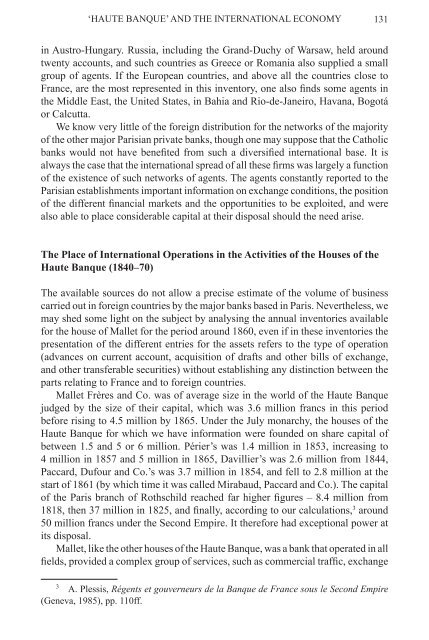the world of private banking
the world of private banking
the world of private banking
Create successful ePaper yourself
Turn your PDF publications into a flip-book with our unique Google optimized e-Paper software.
‘HAUtE BANqUE’ AND tHE INtERNAtIONAL EcONOmy 131<br />
in Austro-Hungary. Russia, including <strong>the</strong> Grand-Duchy <strong>of</strong> Warsaw, held around<br />
twenty accounts, and such countries as Greece or Romania also supplied a small<br />
group <strong>of</strong> agents. If <strong>the</strong> European countries, and above all <strong>the</strong> countries close to<br />
France, are <strong>the</strong> most represented in this inventory, one also finds some agents in<br />
<strong>the</strong> Middle East, <strong>the</strong> United States, in Bahia and Rio-de-Janeiro, Havana, Bogotá<br />
or Calcutta.<br />
We know very little <strong>of</strong> <strong>the</strong> foreign distribution for <strong>the</strong> networks <strong>of</strong> <strong>the</strong> majority<br />
<strong>of</strong> <strong>the</strong> o<strong>the</strong>r major Parisian <strong>private</strong> banks, though one may suppose that <strong>the</strong> Catholic<br />
banks would not have benefited from such a diversified international base. It is<br />
always <strong>the</strong> case that <strong>the</strong> international spread <strong>of</strong> all <strong>the</strong>se firms was largely a function<br />
<strong>of</strong> <strong>the</strong> existence <strong>of</strong> such networks <strong>of</strong> agents. The agents constantly reported to <strong>the</strong><br />
Parisian establishments important information on exchange conditions, <strong>the</strong> position<br />
<strong>of</strong> <strong>the</strong> different financial markets and <strong>the</strong> opportunities to be exploited, and were<br />
also able to place considerable capital at <strong>the</strong>ir disposal should <strong>the</strong> need arise.<br />
The Place <strong>of</strong> International Operations in <strong>the</strong> Activities <strong>of</strong> <strong>the</strong> Houses <strong>of</strong> <strong>the</strong><br />
Haute Banque (1840–70)<br />
The available sources do not allow a precise estimate <strong>of</strong> <strong>the</strong> volume <strong>of</strong> business<br />
carried out in foreign countries by <strong>the</strong> major banks based in Paris. Never<strong>the</strong>less, we<br />
may shed some light on <strong>the</strong> subject by analysing <strong>the</strong> annual inventories available<br />
for <strong>the</strong> house <strong>of</strong> Mallet for <strong>the</strong> period around 1860, even if in <strong>the</strong>se inventories <strong>the</strong><br />
presentation <strong>of</strong> <strong>the</strong> different entries for <strong>the</strong> assets refers to <strong>the</strong> type <strong>of</strong> operation<br />
(advances on current account, acquisition <strong>of</strong> drafts and o<strong>the</strong>r bills <strong>of</strong> exchange,<br />
and o<strong>the</strong>r transferable securities) without establishing any distinction between <strong>the</strong><br />
parts relating to France and to foreign countries.<br />
Mallet Frères and Co. was <strong>of</strong> average size in <strong>the</strong> <strong>world</strong> <strong>of</strong> <strong>the</strong> Haute Banque<br />
judged by <strong>the</strong> size <strong>of</strong> <strong>the</strong>ir capital, which was 3.6 million francs in this period<br />
before rising to 4.5 million by 1865. Under <strong>the</strong> July monarchy, <strong>the</strong> houses <strong>of</strong> <strong>the</strong><br />
Haute Banque for which we have information were founded on share capital <strong>of</strong><br />
between 1.5 and 5 or 6 million. Périer’s was 1.4 million in 1853, increasing to<br />
4 million in 1857 and 5 million in 1865, Davillier’s was 2.6 million from 1844,<br />
Paccard, Dufour and Co.’s was 3.7 million in 1854, and fell to 2.8 million at <strong>the</strong><br />
start <strong>of</strong> 1861 (by which time it was called Mirabaud, Paccard and Co.). The capital<br />
<strong>of</strong> <strong>the</strong> Paris branch <strong>of</strong> Rothschild reached far higher figures – 8.4 million from<br />
1818, <strong>the</strong>n 37 million in 1825, and finally, according to our calculations, around<br />
50 million francs under <strong>the</strong> Second Empire. It <strong>the</strong>refore had exceptional power at<br />
its disposal.<br />
Mallet, like <strong>the</strong> o<strong>the</strong>r houses <strong>of</strong> <strong>the</strong> Haute Banque, was a bank that operated in all<br />
fields, provided a complex group <strong>of</strong> services, such as commercial traffic, exchange<br />
<br />
A. Plessis, Régents et gouverneurs de la Banque de France sous le Second Empire<br />
(Geneva, 1985), pp. 110ff.












![[Pham_Sherisse]_Frommer's_Southeast_Asia(Book4You)](https://img.yumpu.com/38206466/1/166x260/pham-sherisse-frommers-southeast-asiabook4you.jpg?quality=85)



